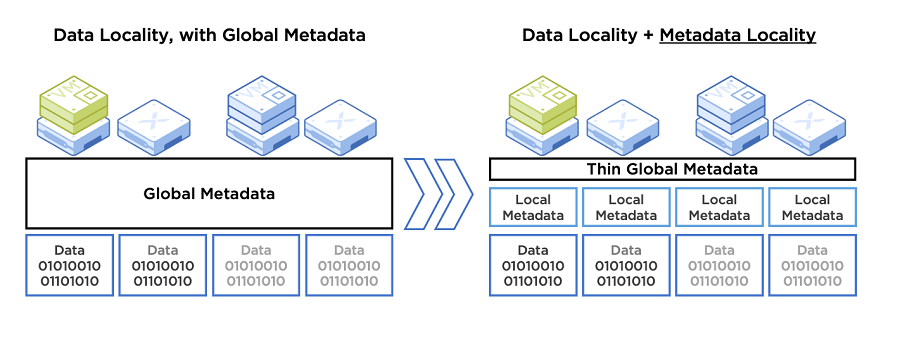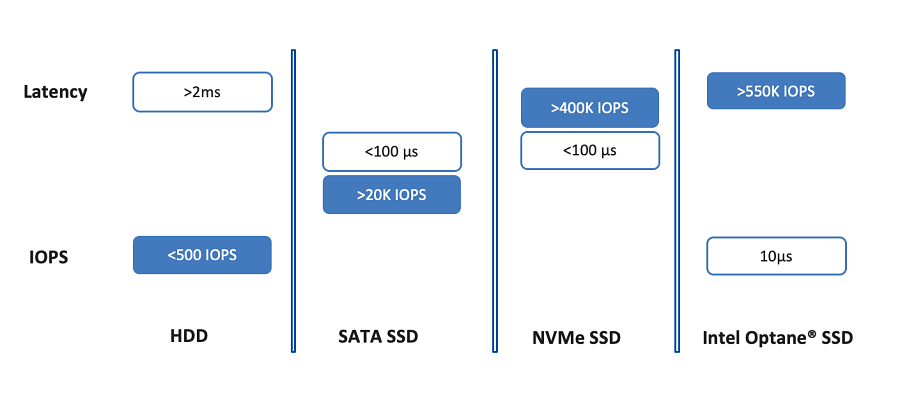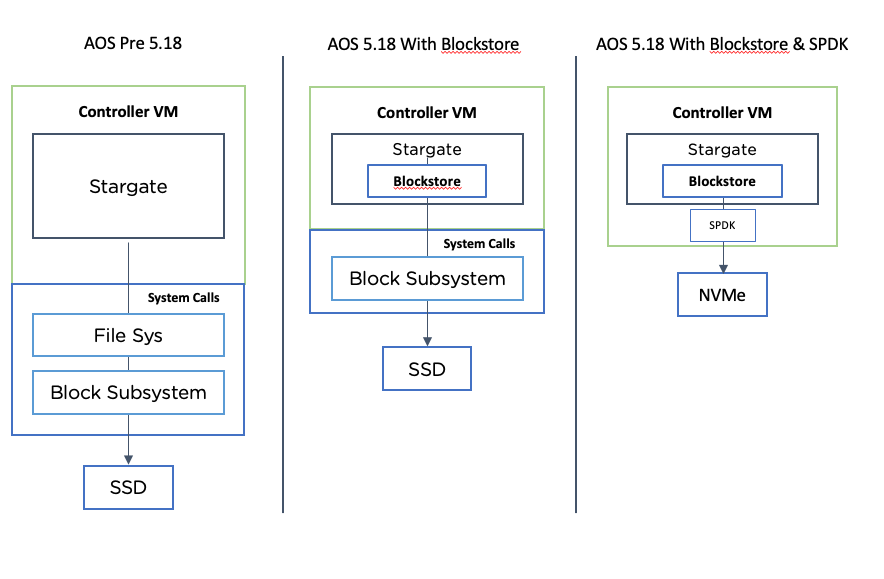Thousands of organizations across the globe trust Nutanix hyperconverged infrastructure (HCI) to run their mission-critical applications. The introduction of Blockstore and SPDK integration with the AOS 5.18 release takes application performance to new heights and unlocks the power of the latest storage technologies like NVMe, enabling Nutanix customers to optimize the performance of their most demanding workloads. And with the recent launch of Nutanix Clusters, customers can confidently run their applications in any cloud – private or public.
The backbone of AOS is its web-scale architecture built from the ground up with key tenets unique to Nutanix. Nutanix delivers superior performance with data locality, ensuring that data remains close to the application. Scale-out architecture with fine-grained metadata enables both uncompromising resiliency and flexible yet predictable scaling. Finally, a user space architecture delivers optimal resiliency, security, and performance, while enabling AOS engineers to maintain a high pace of robust feature innovation.
Timeless Value
Over the years Nutanix has significantly enhanced the performance and TCO of its solution. One such innovation introduced in 2018, Autonomous Extent Store (AES), extends the concept of data locality to metadata, delivering up to 2X higher sustained performance. With AES, customers are not only running workloads that are mission critical, but also life critical, such as demanding healthcare applications EPIC and Meditech. And, building on Nutanix HCI’s web-scale foundation, we delivered this faster performance architecture via a simple, one-click upgrade while ensuring maximum availability. This is akin to the acceleration boost you get with a Tesla via an over the air software update.

Figure 1 - Nutanix AES
Back to the Future
Advances in distributed systems technology combined with the maturation of SSDs has enabled HCI to overtake SAN storage as the architecture of choice for a growing number of organizations.
With AOS 5.18, we are yet again introducing new architectural advancements inspired by new storage technologies that promise substantially faster performance. The NVMe interface, most notably, delivers high throughput and fast response times compared to traditional SATA or SAS interfaces by leveraging parallel low latency access to the underlying media.
Another example is Intel® Optane devices with memory-class storage architectures that can deliver an order of magnitude lower latency. New technologies enable new possibilities. However, to unlock the potential new approaches are needed:
- Movement away from networked storage: The growth of NVMe accelerates the trend towards bringing data and compute closer together. For HCI, this means keeping application data on the same physical node as the workload. It should be no surprise that applications see the biggest benefit from NVMe devices when they are co-located on the same server as their data set.
- Decreasing reliance on operating systems: The increase in available storage performance has altered the way applications access data. Access to NVMe devices is moving away from operating system interrupt-based handling to user-space polling models, which greatly decreases the amount of CPU required to handle each I/O request while decreasing latency.

Figure 2 - Storage Media Performance Evolution
HCI solutions are ideally positioned to deliver maximum benefit from this new generation of technologies - without the need to redesign applications or to implement new types of networks. Importantly, Nutanix enables unmatched scaling and investment protection by allowing organizations to non-disruptively modernize infrastructure by adding new nodes with NVMe devices to existing clusters with all SSD nodes.
New Generation AOS
Nutanix AOS is the only HCI solution that runs in user space and is designed with data locality, enabling maximum performance and efficiency from new media technologies. The new generation AOS that started with AES is taking another leap forward with Blockstore and SPDK technologies that are purpose-built for high throughput, low latency applications and uniquely designed to leverage new media.
Nutanix Blockstore efficiently manages storage media and I/O with lower CPU overhead and lower latency. Blockstore features a user space file system layer and a block management layer that greatly reduces system calls and kernel overhead while servicing I/O operations. Blockstore enables AOS to store data quickly and efficiently on any physical device (NVMe, SSD, or HDD). Initially, it is being rolled out to All-Flash systems with one or more NVMe devices, with broader roll-out in subsequent releases.

Figure 3 - AOS with Blockstore and SPDK
Blockstore enables AOS to leverage Intel SPDK (Storage Performance Development Kit) for direct access of NVMe devices from user space. SPDK implements a lockless, polled-mode, asynchronous NVMe driver written in user space. This enables AOS with zero-copy, highly parallel direct access to NVMe and Intel Optane devices, which decreases latency and CPU utilization. SPDK integration is in technology preview.
Accelerate Performance by up to 50%
Together, Blockstore and SPDK deliver a new lean and highly efficient AOS data path that works with the industry leading hypervisors – AHV, ESXi, and Hyper-V. Blockstore and SPDK enable AOS to extract maximum performance from NVMe SSDs and Intel Optane SSDs. Finally, a 100 percent user space architecture delivers the superior fault isolation, security isolation, and scalable performance.
The combination of New AOS and cutting edge technologies enables new workload possibilities, allowing you to consolidate more applications on Nutanix, including demanding low latency and high throughput applications. Together these capabilities also significantly lower the total cost of ownership (TCO) by enhancing application and VM density on your infrastructure, whether you are running Databases, VDI, or any other application.
Learn more:
Attend NEXT Level Hyperconverged Performance Innovations at .Next 2020
Read the Enterprise Strategy Group (ESG) Performance Whitepaper
© 2020 Nutanix, Inc. All rights reserved. Nutanix, the Nutanix logo and the other Nutanix products and features mentioned on this post are registered trademarks or trademarks of Nutanix, Inc. in the United States and other countries. All other brand names mentioned on this post are for identification purposes only and may be the trademarks of their respective holder(s). This post may contain links to external websites that are not part of Nutanix.com. Nutanix does not control these sites and disclaims all responsibility for the content or accuracy of any external site.